Homeowner Mobility and Impediments to Moving Housing Insights

Existing homeowner mobility declined sharply prior to the Great Recession and, although it has recovered somewhat in recent years, remains approximately 30 percent below mobility rates observed in the early 2000s. Existing home sales represent the vast majority of home sales in the United States, and the ability and willingness of existing homeowners to move (i.e., homeowner mobility) is a crucial dimension of the single-family housing market with important implications for housing supply and the number of overall home sales.1
Earlier in the past decade repeat buyers constituted two-thirds of the conventional owner-occupied Fannie Mae purchases, while more recently in 2018 and 2019 that share dropped to less than 50 percent (Figure 1).2 Repeat homebuyers are also now five years older at the time of mortgage origination compared to their peers from a decade ago, suggesting a delay in their move to the next home (Figure 2).3
Analyzing a set of recent mobility-related responses from Fannie Mae's National Housing Survey® (NHS), we find that lower prevailing mortgage rates, joint employment considerations, and household financial constraints related to buying the next house are among the most important deterrents repeat buyers continue to face.
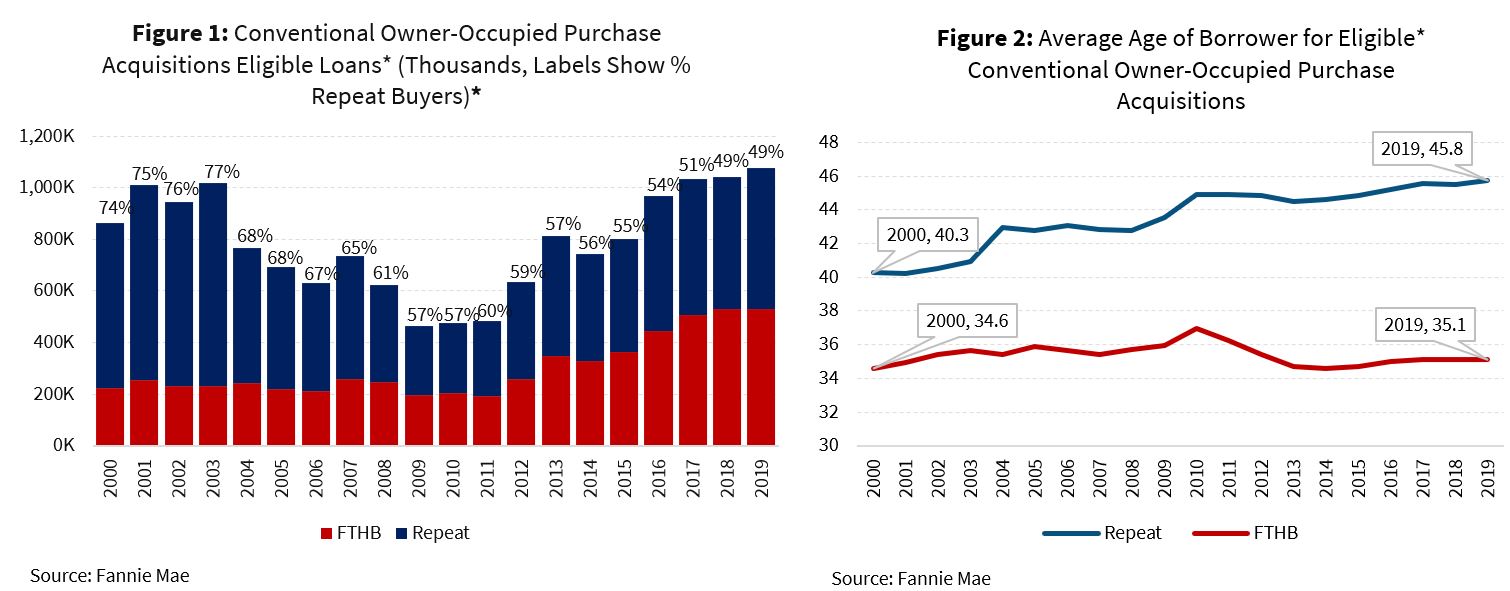
*We exclude ineligible loans such as loans lower than 620 FICO credit score, higher than 97 percent original loan-to-value ratio, more than 50 percent debt-to-income ratio, and ineligible products such as negatively amortizing loans, 40-year terms, and interest-only loans. See Fout et.al (2018) for more details on the ineligible population.
Mobility Recovers for Younger Cohorts as Renters Transition into Homeownership
Much recent analysis has highlighted a long-term dramatic decline of U.S. household mobility over at least the last 20 years using data gathered from the Current Population Survey (CPS).4 Mobility estimates extracted using alternative data sets, such as the American Community Survey (ACS) and Fannie Mae loan data, tell a more nuanced story.5 Figure 3 shows the percentage of households that moved one year prior for all current owner households, and for current owner households with mortgages derived from the ACS Public Use Microdata Sample (PUMS).6 Homeowner mobility measured in this way declined sharply during the Great Recession but has been recovering in recent years, especially between 2015 and 2017.7 It has not, however, reached the levels of the early 2000s, and has somewhat stabilized in 2018 (the most recent year of ACS data), likely driven by the slowdown of home sales in the higher interest rate environment of 2018 compared to 2017. The mobility rate of homeowners with mortgages follows a similar pattern to the overall owner households and has recovered relatively faster since 2011. We focus on the homeowner mobility rates for households with mortgages for the remainder of our analysis.
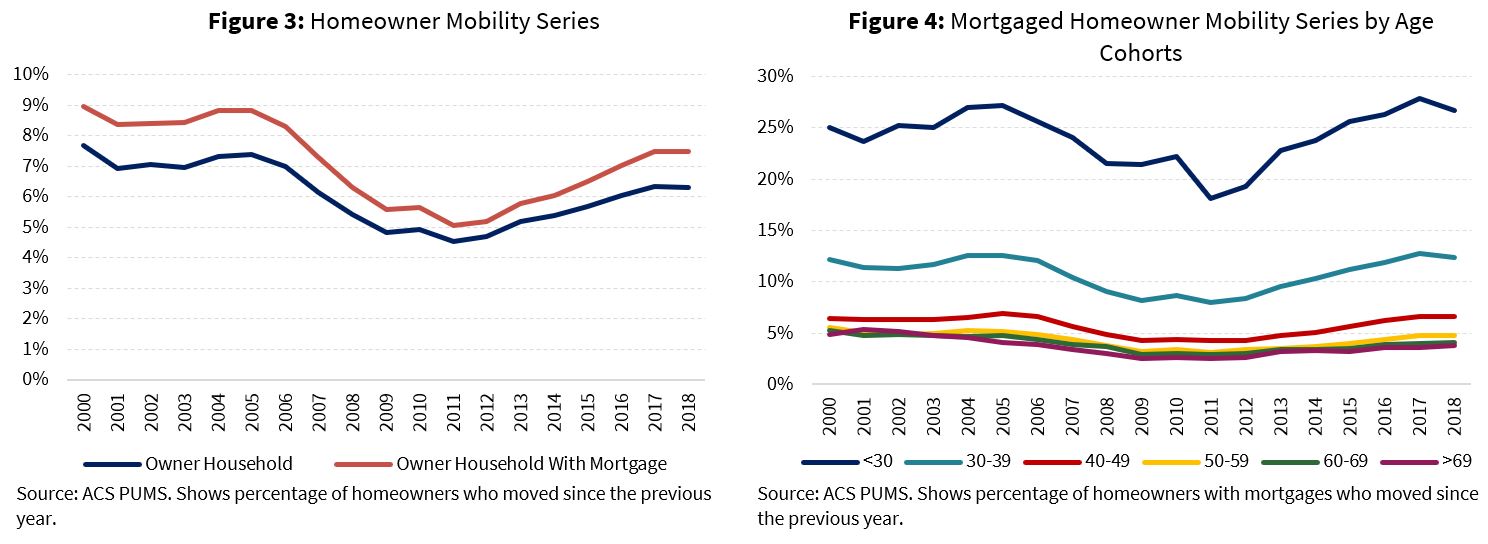
The ACS mobility measure we construct here includes both renter households moving into owner households as well as owner households buying and moving into another owned residence. We are primarily interested in the dynamics of the latter, namely current homeowners becoming repeat buyers and, in many cases, releasing their inventory to prospective first-time homebuyers. Unfortunately, we cannot isolate owner-to-owner transitions using our ACS mobility measures. We can, however, control for age and assume that younger movers more likely represent renter-to-owner transitions.
When we break mobility down by age cohort in this way (Figure 4), we find that homeowner mobility has fully recovered for the youngest cohorts (<30 years old), surpassing its early-2000s level. This pickup in the mobility of younger cohorts is likely due to the increased first-time homebuyer activity in recent years as younger renters transition into homeownership. The share of the youngest two cohorts (<40 years old) accounted for almost 50 percent of the moves among 2018 homeowners in the ACS sample. However, these highly mobile younger homebuyers constitute a little less than a quarter of all homeowners with mortgages, while the remaining less mobile older cohorts make up the majority of the overall distribution (Figure 5).
Figure 6 plots the cumulative growth of first-time homebuyers versus repeat buyers for aggregate purchase issuance for Fannie Mae, Freddie Mac, and Ginnie Mae since 2014 in an effort to put the trend we observe in Figure 1 of declining repeat buyer share for Fannie Mae into the broader agency context. Here, we observe the growth of first-time homebuyers (+48 percent) has significantly outpaced the growth of repeat buyers (+21 percent) across the agency space over the last five years (i.e., 2015 through 2019).8 Figure 6 also plots the GSE agency market shares for first-time homebuyers and repeat buyers. While agency first-time homebuyers are roughly equally divided between government and conventional products, the GSEs are the primary channel for agency repeat buyers. As such, more than two-thirds of loans to agency repeat buyers in 2015 went to the GSEs, with the share increasing to 73 percent by 2019.

Recovery in Mobility is Smaller for Older Repeat Homeowners
Next, we turn to data from Fannie Mae purchase loans to more accurately identify owner-to-owner transitions. In particular, we use proprietary Fannie Mae data to track whether owner-occupied purchasers move again within a specified time window. Searching for an arms-length transaction in Fannie Mae's property transaction database we measure moves by voluntary sale of the underlying property.9 Here we present the percentage of Fannie Mae homeowners who moved within five years of the initial purchase date.10
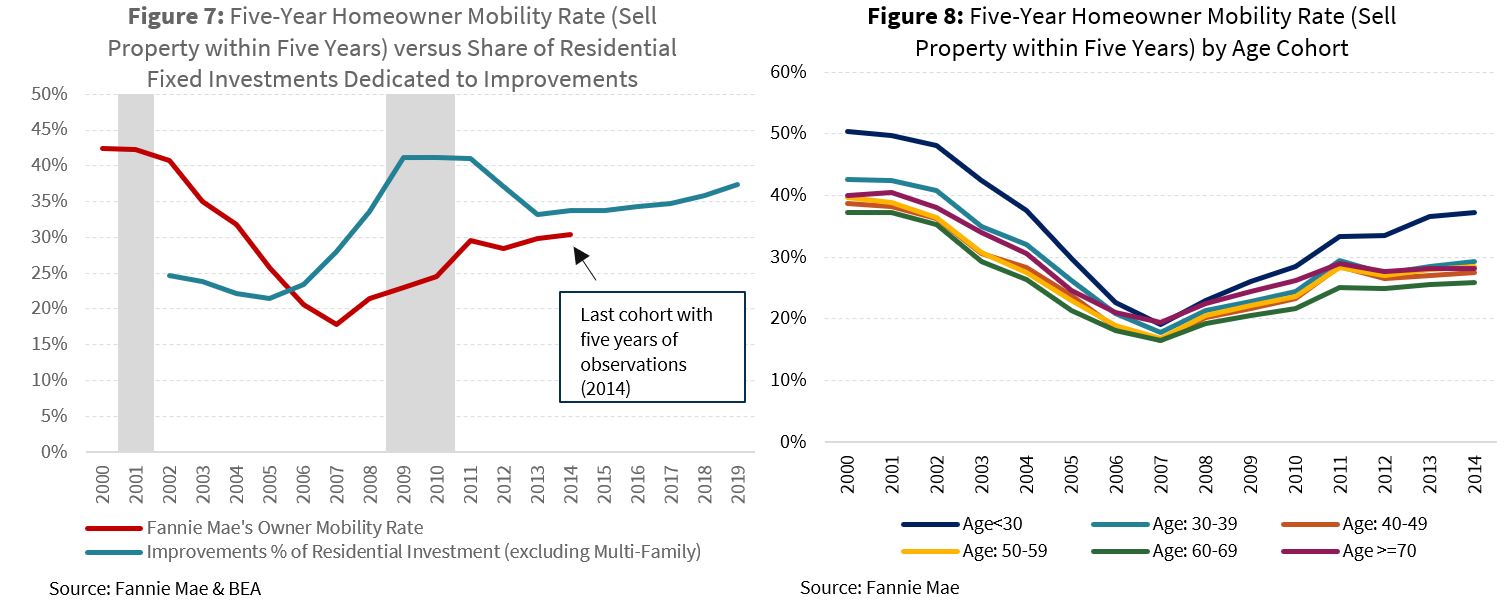
Fannie Mae's five-year owner mobility rate shows a similar historical pattern to the ACS-based measure discussed above. The correlation between the two series is over 80 percent when we roll Fannie Mae's mobility rate forward by five years.11 Like the ACS measure, our Fannie Mae owner mobility rate declined sharply around the Great Recession and recovered to some extent once the economy began recovering. Only about 30 percent of owners with a Fannie Mae mortgage who bought their home in 2014 had moved through 2019, a drop from over 40 percent of those who originated a purchase loan in 2000 (Figure 7). This approximate 30 percent decline relative to the pre-Great Recession mobility rate has corresponded with an uptick in the share of residential fixed investment devoted to home improvement, indicating renovation may be serving as a potential substitute for trading up in recent years. We take a closer look at renovation as part of our analysis around continuing impediments to existing homeowner mobility further below.
As the Fannie Mae mobility measure includes only the repeat homeowner moves and excludes renter-to-owner moves, we do not see the same dramatic recovery in mobility in the youngest cohort that we observe in ACS (Figure 8)12. The recovery in existing homeowner mobility has been slower for borrowers in their 30s. In particular, this group of homeowners experiences the biggest reduction in mobility by around 35 percent compared to mobility in 2000. In summary, looking at the ACS and Fannie Mae estimates, household mobility has increased following the Great Recession, driven by younger buyers transitioning into homeownership (as seen from ACS mobility rates) and by younger existing homeowners turning over more frequently (as seen from the Fannie Mae data). Furthermore, existing homeowner mobility, while improving, has not returned to its pre-Great Recession levels.
Potential Impediments to Mobility
From a long-run perspective, Figure 8 indicates homeowners across the age spectrum are moving less frequently compared to their peers from the previous decade. This suggests that there are remaining barriers to moving. In this section, we discuss potential drivers of the continued shortfall in mobility compared with the early 2000s. We begin with the effect of negative equity on household mobility.13 The general idea is that with rapid price depreciation, if homeowners owe more than the value of their house, they will be less likely to sell and move. Being underwater, however, could potentially increase mobility because of increased likelihood of default (Coulson and Grieco 2012). Isolating voluntary moves (as we also do in our analysis), Andersson and Mayock (2014) find voluntary household mobility declined by around 25 percent due to reductions in equity between 2006 and 2010. Despite continued increases in home prices and equity levels nationwide, the equity perception among homeowners may still be pessimistic.14 Even low levels of positive equity, in this context, may be enough of a deterring factor for voluntary moves.
Another potential impediment to mobility is the lock-in effect created by the low interest rate environment in the wake of the Great Recession. If move-up buyers have mortgage rates much lower than the prevailing market rates, they may be reluctant to give up this rate and bear the cost of buying and moving with the additional burden of paying a higher rate of interest (some of this burden may be psychological).15 Increasing household debt relative to income could also be contributing to affordability pressures that continue to limit move-up borrowers.
Affordability issues, a third driver, may represent the biggest impediment to homeowner mobility. Limited inventory and fast price appreciation put pressure on prospective repeat buyers and make it harder for those trying to find the specific home that fits their needs and preferences. If available housing supply does not suit their needs, postponing the move or simply renovating-in-place as an alternative to moving are options.
Relocation difficulties among two-earner households is another potential limiting factor for mobility. Coordinating a relocation of both jobs can be difficult for two-earner households, decreasing the likelihood of moving across areas especially for out-of-area moves.
A final set of factors relate to life cycle issues and changes in household formation. Housing relocation decisions are often related to life cycle events in the household (e.g., marriage, children, loss of a spouse).16 Households having fewer children, younger adults delaying marriage, an aging population, and older homeowners potentially delaying downsizing due to factors such as adult children living at home or longer life expectancy are potential drivers behind the observed shift in traditional patterns of household mobility.
In an aim to measure and evaluate these potential impediments to mobility, we turn to results from a special topic devoted to mobility in Fannie Mae's National Housing Survey in Q2 and Q3 of 2019. Figures 9 and 10 present answers to survey questions related to mobility. We define delayed move-up buyers as homeowners between ages 30 and 44 with a mortgage, currently living in their first home for at least five years. We compare the responses of this group with all other mortgage holders.
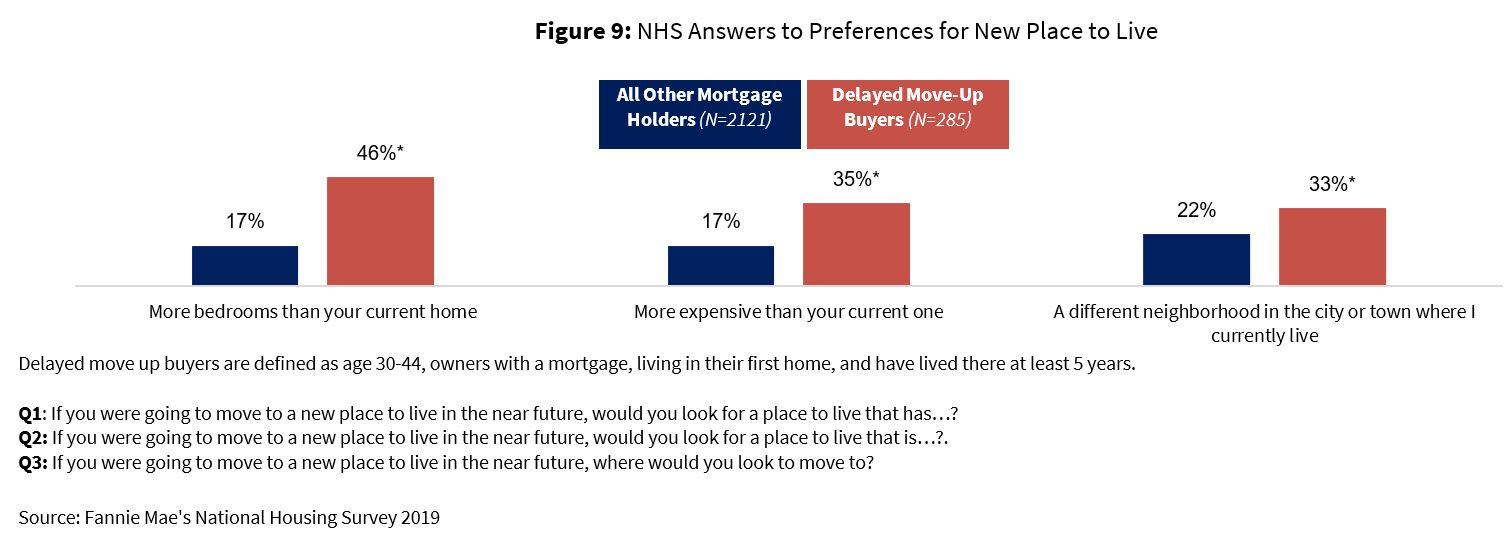
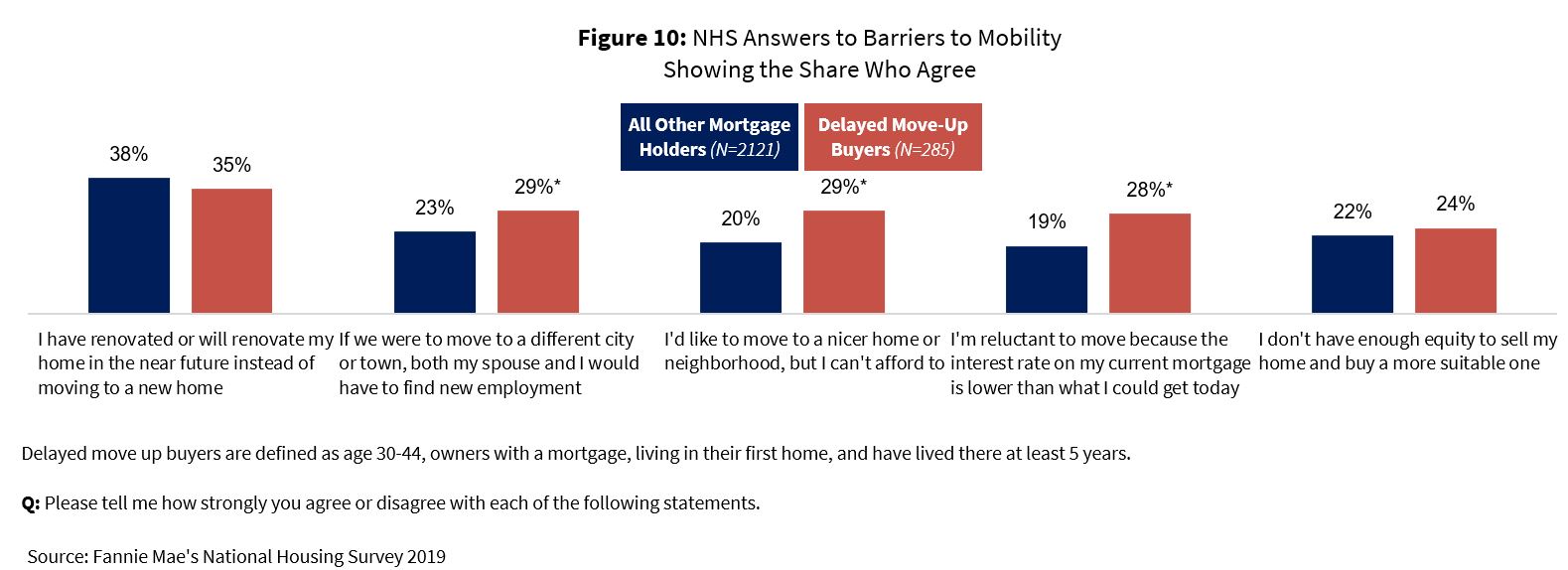
Delayed move-up buyers are more likely to say that if they were going to move to a new place to live in the near future, they would look for a place that has more bedrooms and is more expensive than their current one in the same city or town where they currently live, potentially in a different neighborhood. In summary, delayed move-up buyers prefer bigger, more expensive homes and want to stay local. This is consistent with life cycle explanations of mobility for this age group (e.g., this group of homeowners may want more space as they have children and thus may look in their preferred school district in the same metropolitan area where they currently live and work).
Respondents were also asked how strongly they agree with certain statements related to mobility presented in Figure 10. We find that delayed move-up buyers were significantly more likely to agree that they are reluctant to move because they have a lower current mortgage rate than the prevailing market rate and that they would like to move to a nicer home but cannot afford to. They are also more likely to agree that both earners of the household must find a job to move out of their current area. Answers to questions related to equity lock-in and renovations were not significantly different than what other mortgage holders said. In fact, more homeowners with mortgages (38%) agreed with the statement "I have renovated or will renovate my home in the near future instead of moving to a new home" than any other mobility barrier survey question. Homeowners are more likely to see renovation as an alternative to moving regardless of age, tenure (number of years spent in house), or repeat buyer status, showing how renovation spending can potentially slow down existing homeowner mobility across the board.
In summary, we find some evidence that repeat buyers could be delaying moves due to rate-lock in, affordability concerns, and relocation difficulties for out-of-area moves.
Conclusion
In this Housing Insights, we have presented evidence that household mobility declined sharply during the Great Recession but has recovered more recently, driven by renters transitioning into homeownership and younger existing homeowners moving more frequently. We find, however, that existing homeowner mobility rates remain approximately 25 percent lower than the pre-Great Recession period (circa 2000). Breaking down by age, we observe the biggest mobility declines among existing homeowners in their 30s, but that mobility has declined across age groups; both findings are in line with the observed aging of repeat buyers in the conventional mortgage market.
Existing homeowner mobility is traditionally a mechanism that encourages affordable supply as repeat buyers move out of lower price tiers and into the upper price tiers of particular markets. The slowdown in repeat buyer activity over the last decade has contributed to continued inventory problems, especially for lower priced starter homes for which annual price appreciation has been consistently higher than for higher-priced homes and the strongest for lowest-priced homes at least through March 2020.17 Housing supply will potentially get even more constrained if repeat buyers keep holding on to existing home inventories longer.
To better understand the impediments to homeowner mobility, we analyzed responses to a set of mobility-related questions as part of Fannie Mae's 2019 Q2 and Q3 National Housing Survey. Our survey results indicate some move-up buyers are delayed because of rate lock-in effects, joint employment relocation considerations, and the financial constraints associated with the desire to find a larger home in a particular area.
The recent emergency declarations across the United States, along with social distancing and other restrictions that were put in place to mitigate the spread of the COVID-19 virus could potentially present additional impediments to the mobility of repeat buyers. Mortgage rates have also hit all-time lows over the last few months, suggesting interest rate lock-in effects could further slow future mobility. Since February, existing single-family home sales have declined by approximately 25 percent through May, and in our most recent Economic and Housing Outlook published on June 12, 2020, we expect a full-year 2020 decline in existing home sales of approximately 11 percent. We plan to revisit the impact of the COVID-19 pandemic on mobility in detail in a future analysis.
Hamilton Fout
Vice President, Economic & Strategic Research Group
Ozge Savascin Oundee
Senior Economist, Economic & Strategic Research Group
July 10, 2020
The authors would like to thank Jaclene Begley, Eric Brescia, Sarah Shahdad, Alexis McNutt Unis, Doug Duncan, Mark Palim, participants of the Housing Statistics User Group Meeting Fall 2019, FHFA’s Q1 2020 Economic Summit, American Economic Institute Housing Center Collaborative February 2020 and Fannie Mae Analytics Day 2019 for valuable comments and support in creating this Housing Insights. All errors and omissions are the responsibility of the authors.
Opinions, analyses, estimates, forecasts and other views of Fannie Mae's Economic and Strategic Research (ESR) Group included in these materials should not be construed as indicating Fannie Mae's business prospects or expected results, are based on several assumptions, and are subject to change without notice. How this information affects Fannie Mae will depend on many factors. Although the ESR group bases its opinions, analyses, estimates, forecasts and other views on information it considers reliable, it does not guarantee that the information provided in these materials is accurate, current or suitable for any particular purpose. Changes in the assumptions or the information underlying these views could produce materially different results. The analyses, opinions, estimates, forecasts and other views published by the ESR group represent the views of that group as of the date indicated and do not necessarily represent the views of Fannie Mae or its management.
References
Andersson, Fredrik, and Tom Mayock. "How does home equity affect mobility?" Journal of Urban Economics 84 (2014): 23-39.
Boesel, Molly. "Lower-Priced Homes Had the Highest Annual Appreciation in August, but Also the Largest Slowdown in Appreciation", CoreLogic Housing Index Insights: August 2019 https://www.corelogic.com/blog/2019/10/lower-priced-homes-had-the-highest-annual-appreciation-in-august-but-also-the-largest-slowdown-in-appreciation.aspx
Boesel, Molly. "Home Prices Hold up in March, But Are Expected to Soften Over the Year", CoreLogic Housing Index Insights: March 2020 https://www.corelogic.com/blog/2020/5/home-prices-hold-up-in-march-but-are-expected-to-soften-over-the-year.aspx
Coulson, N. Edward, and Paul LE Grieco. "Mobility and mortgages: Evidence from the PSID." Regional Science and Urban Economics 43.1 (2013): 1-7.
Deggendorf, Steve, and James Wilcox. "Invisible Equity: Do Homeowners See How Much Home Equity They Are Sitting On?" Fannie Mae Perspectives (08/03/2015) https://www.fanniemae.com/portal/research-insights/perspectives/080315-deggendorf-wilcox.html
Fout, H., Li, G., Palim, M. & Pan, Y. (2018). "Credit risk of low income mortgages" Regional Science and Urban Economics.
Gupta, Manish. "Mobility and Mortgage" January 3-5, 2015 AEA Annual Meetings Boston, USA. (2019)
Hendershott, Patric H., Jin Man Lee, and James D. Shilling. "The 2005–2011 Housing Boom and Bust: Impacts on Housing Turn over and Implications for the Recovery." Journal of Real Estate Research 37.4 (2015): 471-498.
Ihrke, David. "United States Mover Rate at a New Record Low", Census Blogs (01/23/2017) https://www.census.gov/newsroom/blogs/random-samplings/2017/01/mover-rate.html
Masnick, George. "Different Data Sources Tell Different Stories About Declining Geographic Mobility" Harvard Housing Perspective Blog (02/20/2013) https://www.jchs.harvard.edu/blog/different-data-sources-tell-different-stories-about-declining-geographic-mobility/
Molloy, R., Smith, C. & Wozniak, A. (2011) "Internal migration in the United States" Journal of Economic Perspectives 25, 173-196.
Moore, Derick. "Overall Mover Rate Remains at an All-time Low", Census (12/21/2017) https://www.census.gov/library/stories/2017/12/lower-moving-rate.html
Morrow-Jones, Hazel A., and Mary V. Wenning. "The housing ladder, the housing life-cycle and the housing life-course: Upward and downward movement among repeat home-buyers in a US metropolitan housing market." Urban Studies 42.10 (2005): 1739-1754.
Savascin, Ozge. "Struggling Creditworthy Repeat Homebuyers: Mid-Tier FICO Analysis" Fannie Mae Housing Insight Series, Washington DC (2015)
Tavernise, Sabrina. "Frozen in Place: Americans Are Moving at the Lowest Rate on Record", NY Times (11/20/2019) https://www.nytimes.com/2019/11/20/us/american-workers-moving-states-.html
Economic & Strategic Research (ESR) Group, "All Expansions Come to an End, Some Suddenly So" Fannie Mae Monthly Forecast (06/15/2020) https://www.fanniemae.com/portal/research-insights/forecast/monthly/economic-developments/june-2020.html
1 In 2019, existing home sales made up approximately 90 percent of all single-family home sales.
2 We first noted the decline in repeat buyers in 2015 when we published a Housing Insights that identified a decline in repeat buyers as the primary driver for the reduction of mid-tier FICO credit score acquisitions, even after controlling for changes in underwriting standards (Savascin 2015).
3 Repeat buyers are defined as not first-time homebuyers (FTHB). The first-time homebuyer definition follows the Internal Revenue Service’s definition where a loan is classified as being made to a first-time homebuyer if any of the borrowers on the loan meet either of the following criteria: 1) Had no homeownership interest during the three years prior to the purchase date, or 2) Is a displaced homeowner or single parent who had no homeownership interest other than a joint ownership with a spouse.
4 See Ihrke and Moore (2017) and Tavernise (2019), for example.
5 Molloy (2011) and Masnick (2013) document similar differences between ACS and CPS. The discrepancy may be due to sampling differences between the two surveys. While CPS is count-based and assumes nationally representative coverage, ACS uses a representative sampling methodology which can produce a more accurate view of the population, putting necessary weights on likely undercounted groups such as minorities (Alberta 2009).
6 We focus on households represented only by head of household, as individual moves within the household do not represent the collective move of the household we are interested in here. The survey also includes question on ownership type, which can be used to identify homeowners from renters.
7 Since we restrict the ACS sample to head of households, we have one observation per household. Hence, to convert this to a population-based metric we apply household weights in constructing our ACS mobility estimates.
8 Agency issuances consist of conventional conforming loans securitized through the Government Sponsored Enterprises (GSE), Fannie Mae and Freddie Mac, as well as government loans securitized through Ginnie Mae.
9 We remove defaults from our owner-occupied sample to focus only on voluntary moves. One of the drawbacks of this approach is that by restricting moves only to sales we would be assuming those who did not sell stayed in their properties. However, no record of sale does not necessarily mean the borrower did not move. Some households buy another home without selling their existing one, by converting their existing property into an investment property. This could mean our move rate is underestimated. To enhance our matching algorithm for those that did not sell but still moved we additionally search for the borrowers within Fannie Mae's acquisition database. This way we can identify at least some portion of those who did not sell but still got a new purchase mortgage underwritten by Fannie Mae. Moves in our sample also include potential owner to renter moves. However, this cannot be tracked or identified.
10 For the five-year conditional mobility measure, 2014 is the last cohort with five years of observations (through December 2019). Our results are robust to various moving timelines, including three, five and seven years after initial loan origination.
11 Our metric is forward-looking for five years while ACS is backward-looking for one year. Thus, mobility rates are higher in Fannie Mae's approximations (Figures 7 and 8) compared to ACS measures (Figures 3 and 4).
12 In Fannie Mae's mobility data when there are two borrowers, age is defined as the youngest of the two.
13 See Gupta (2019) for extensive discussion around negative equity on household mobility.
14 See for instance Deggendorf and Wilcox (2015).
15 An unintended consequence of post-Great Recession housing policies such as the Home Affordable Refinance Program (HARP) and Home Affordable Modification Program (HAMP) may have been reduced mobility for homeowners who took advantage of the lower interest rates these programs provided. While HARP helped homeowners who owed more than the value of their property by letting them refinance into lower rates and reducing their monthly payments, HAMP focused on homeowners who were delinquent on their payments and offered affordable modification of mortgage terms which often resulted in reduced interest rates.
16 See Hendershott, Lee and Shilling (2015) and Morrow-Jones and Wenning (2005) for an extensive literature review on life cycle and household mobility.
17 See, for instance, Boesel (2019, 2020).
